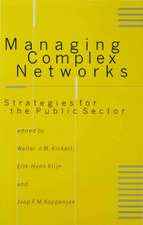Managing Uncertainties in Networks: Public Private Controversies
Autor Joop Koppenjan, Erik-Hans Klijnen Limba Engleză Hardback – 27 mai 2004
Differentiating itself from other policy network approaches which mainly have a research focus, this text has a managerial orientation, presenting strategies and management recommendations for public and private sector organizations as well as the analytical tools required by practitioners seeking to support their own internal decision-making and strategy formulation.
Tapping into the important and ever-growing area of risk and uncertainty management, this is a vital and long awaited staple for the arena, written by two leading authors in the field, and is key reading for students, scholars and policy makers seeking to understand the complexities of the network society.
| Toate formatele și edițiile | Preț | Express |
|---|---|---|
| Paperback (1) | 473.88 lei 6-8 săpt. | |
| Taylor & Francis – 27 mai 2004 | 473.88 lei 6-8 săpt. | |
| Hardback (1) | 1336.63 lei 6-8 săpt. | |
| Taylor & Francis – 27 mai 2004 | 1336.63 lei 6-8 săpt. |
Preț: 1336.63 lei
Preț vechi: 1630.04 lei
-18% Nou
Puncte Express: 2005
Preț estimativ în valută:
255.77€ • 273.50$ • 213.25£
255.77€ • 273.50$ • 213.25£
Carte tipărită la comandă
Livrare economică 18 aprilie-02 mai
Preluare comenzi: 021 569.72.76
Specificații
ISBN-13: 9780415369404
ISBN-10: 0415369401
Pagini: 306
Ilustrații: 20 black & white line drawings
Dimensiuni: 156 x 234 x 24 mm
Greutate: 0.73 kg
Ediția:1
Editura: Taylor & Francis
Colecția Routledge
Locul publicării:Oxford, United Kingdom
ISBN-10: 0415369401
Pagini: 306
Ilustrații: 20 black & white line drawings
Dimensiuni: 156 x 234 x 24 mm
Greutate: 0.73 kg
Ediția:1
Editura: Taylor & Francis
Colecția Routledge
Locul publicării:Oxford, United Kingdom
Public țintă
PostgraduateCuprins
Part 1: The Analysis of Uncertainties in Dealing with Complex Problems in Networks 1. Uncertainties in Dealing with Complex Problems in the Network Society 2. Uncertainty about Content: Knowledge Conflicts and Asymmetrical Debates 3. Uncertainty and Process: Problem Solving as Strategic Game 4. Uncertainty and Institutions: Patterns, Rules and Trust 5. Uncertainties and Governments: Old and New Responses 6. Summing Up: Dealing with Uncertainties in Networks Part 2: The Management of Uncertainties in Dealing with Complex Problems in Networks 7. Mapping Uncertainties in Games and Networks 8. Managing Content: Furthering Cross-Frame Reflection and the Creation of Negotiated Knowledge 9. Managing the Game 10. Managing the Network: Strategies for Institutional Design 11. Managing Uncertainties in Networks
Recenzii
One thing that befuddles even the most experienced network scholar is how to present networks to public administration students so that the nuances and uniqueness of the network interaction is clear. Unfortunately, there is a dearth of literature aimed at professionals (and for students, future professionals) who operate within network forms of organization. Koppenjan and Klijn seek to fill this void. The book is clearly written and systematically explicates and elaborates their points. It is rare that an academic book is so delightful to read.
One of the most impressive things about the book is its systematic and thorough treatment of uncertainties. The authors take great pains to help the reader understand the critical uncertainties that dealing with interorganizational dynamics present. The discussion on substantive, strategic and institutional uncertainties is detailed, but presented in a realistic and practical way that is useful to practitioners and scholars alike. They strike just the right balance between scholarliness and realism.
The second part of the book brings theory to practice. Not only are these chapters a nice application of theory to practice, but they can also illustrate to students the value of theory in practice – a link often missed by professionally oriented individuals. The authors use the theoretical discussion set up in the first half of the book to elaborate how network managers might approach addressing the three types of uncertainties previously outlined. One chapter is devoted to each of the uncertainties to address practical and concrete ways that someone in a real situation might encounter a particular uncertainty and then what to do about it.
While the chapters that deal with addressing uncertainties are invaluable, I think that they may be a bit overwhelming in practice. The authors present the material in a comprehensive way and the underlying tone is that this is what a network manager ought to be doing. They do admit that the network management function is a laborintensive one and requires almost endless insight and personal human capital, but this seems an afterthought. Even still, these chapters are filled with excellent prescriptive information and fill a void in the literature. Network mangers should read these chapters as ideal sets of tasks and develop a set of heuristics for themselves, based on Koppenjan and Klijn’s suggestions.
An excellent addition to the somewhat scant practice-oriented literature on network management is the presentation of guidelines for action in Chapter 11. Here the authors present nine grounded suggestions to network managers about how to approach network management and how to think about which of the uncertainty prescriptions previously elaborated should be used in what circumstances. These guidelines are a sort of flowchart of management action and do an excellent job of tying together the entire content of the book.
Perhaps the biggest critique of the book is that the authors have presented their work as germane to the unique network paradigm. In fact, this work is much more generalizable to the broader set of interactions between organizations, whether or not those interactions take place in a network. The uncertainties elaborated on in the book are the uncertainties that organizations face whenever they interact with another organization, especially with new partners. Yes, these uncertainties may be somewhat exaggerated when operating in networks, but how much more than when dealing with multi-organizational interactions that are not networked? This book is really about uncertainties in interorganizational relationships.
Perhaps part of this disagreement about scope is related to the confusion surrounding what actually constitutes a network. Organizations can interact with one another, even multiple organizations, without being in a network. Indeed, the literature is wrought with interorganizational interactions that are labeled networks but do not meet the simple criteria of a group of autonomous organizations that come together to joint problem solve, particularly but not necessarily, around joint production functions (Alter and Hage 1993; Chisholm 1998; Milward and Provan 2000). This definition requires direct and concerted interaction among organizations focused on an operational goal. This is what separates networks from both a series of dyadic interactions (see Isett and Provan 2005), and common members of an organizational field (see Powell and DiMaggio 1991). While in many instances Koppenjan and Klijn speak to networks, in most cases they are really addressing the dynamics of a much broader set of organizational interactions.
In the end, this book is an excellent addition to the organizational literature. The discussion on uncertainties is perhaps one of the best published. However, I would not use this book in my networks class. Why? Because the information is too good for such a limited audience. Instead, I would recommend this book to a more general management course. The information on uncertainties and how to deal with them is valuable to all managers that will operate as boundary spanners. The information in this book is such a well-developed and thought-out guide to managing uncertainties, we should not be miserly with it.
REFERENCES
Alter, C. and Hage, J. (1993) Organizations Working Together, Newbury Park, CA: Sage.
Chisholm, R. F. (1998) Developing Network Organizations: Learning from Practice and Theory, Reading, MA: Addison-Wesley.
Isett, K. R. and Provan, K. G. (2005) The Evolution of Dyadic Interorganizational Relationships in a Network of
Publicly Funded Nonprofit Agencies, Journal of Public Administration Research and Theory. 15 pp149 – 65.
Milward, H. B. and Provan, K. G. (2000) Governing the Hollow State, Journal of Public Administration Research and Theory. 10:2 pp359 – 79.
Powell, W. W. and DiMaggio, P. eds (1991) New Institutionalism in Organizational Analysis, Chicago, IL: University of Chicago Press.
Kimberley R. Isett
Columbia University, USA
One of the most impressive things about the book is its systematic and thorough treatment of uncertainties. The authors take great pains to help the reader understand the critical uncertainties that dealing with interorganizational dynamics present. The discussion on substantive, strategic and institutional uncertainties is detailed, but presented in a realistic and practical way that is useful to practitioners and scholars alike. They strike just the right balance between scholarliness and realism.
The second part of the book brings theory to practice. Not only are these chapters a nice application of theory to practice, but they can also illustrate to students the value of theory in practice – a link often missed by professionally oriented individuals. The authors use the theoretical discussion set up in the first half of the book to elaborate how network managers might approach addressing the three types of uncertainties previously outlined. One chapter is devoted to each of the uncertainties to address practical and concrete ways that someone in a real situation might encounter a particular uncertainty and then what to do about it.
While the chapters that deal with addressing uncertainties are invaluable, I think that they may be a bit overwhelming in practice. The authors present the material in a comprehensive way and the underlying tone is that this is what a network manager ought to be doing. They do admit that the network management function is a laborintensive one and requires almost endless insight and personal human capital, but this seems an afterthought. Even still, these chapters are filled with excellent prescriptive information and fill a void in the literature. Network mangers should read these chapters as ideal sets of tasks and develop a set of heuristics for themselves, based on Koppenjan and Klijn’s suggestions.
An excellent addition to the somewhat scant practice-oriented literature on network management is the presentation of guidelines for action in Chapter 11. Here the authors present nine grounded suggestions to network managers about how to approach network management and how to think about which of the uncertainty prescriptions previously elaborated should be used in what circumstances. These guidelines are a sort of flowchart of management action and do an excellent job of tying together the entire content of the book.
Perhaps the biggest critique of the book is that the authors have presented their work as germane to the unique network paradigm. In fact, this work is much more generalizable to the broader set of interactions between organizations, whether or not those interactions take place in a network. The uncertainties elaborated on in the book are the uncertainties that organizations face whenever they interact with another organization, especially with new partners. Yes, these uncertainties may be somewhat exaggerated when operating in networks, but how much more than when dealing with multi-organizational interactions that are not networked? This book is really about uncertainties in interorganizational relationships.
Perhaps part of this disagreement about scope is related to the confusion surrounding what actually constitutes a network. Organizations can interact with one another, even multiple organizations, without being in a network. Indeed, the literature is wrought with interorganizational interactions that are labeled networks but do not meet the simple criteria of a group of autonomous organizations that come together to joint problem solve, particularly but not necessarily, around joint production functions (Alter and Hage 1993; Chisholm 1998; Milward and Provan 2000). This definition requires direct and concerted interaction among organizations focused on an operational goal. This is what separates networks from both a series of dyadic interactions (see Isett and Provan 2005), and common members of an organizational field (see Powell and DiMaggio 1991). While in many instances Koppenjan and Klijn speak to networks, in most cases they are really addressing the dynamics of a much broader set of organizational interactions.
In the end, this book is an excellent addition to the organizational literature. The discussion on uncertainties is perhaps one of the best published. However, I would not use this book in my networks class. Why? Because the information is too good for such a limited audience. Instead, I would recommend this book to a more general management course. The information on uncertainties and how to deal with them is valuable to all managers that will operate as boundary spanners. The information in this book is such a well-developed and thought-out guide to managing uncertainties, we should not be miserly with it.
REFERENCES
Alter, C. and Hage, J. (1993) Organizations Working Together, Newbury Park, CA: Sage.
Chisholm, R. F. (1998) Developing Network Organizations: Learning from Practice and Theory, Reading, MA: Addison-Wesley.
Isett, K. R. and Provan, K. G. (2005) The Evolution of Dyadic Interorganizational Relationships in a Network of
Publicly Funded Nonprofit Agencies, Journal of Public Administration Research and Theory. 15 pp149 – 65.
Milward, H. B. and Provan, K. G. (2000) Governing the Hollow State, Journal of Public Administration Research and Theory. 10:2 pp359 – 79.
Powell, W. W. and DiMaggio, P. eds (1991) New Institutionalism in Organizational Analysis, Chicago, IL: University of Chicago Press.
Kimberley R. Isett
Columbia University, USA
Notă biografică
Joop Koppenjan, Erik-Hans Klijn
Descriere
This unique text examines developments in the area of network strategy. Differentiating itself from other policy network approaches with a mainly research focus, this text has a managerial orientation.























